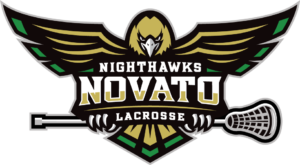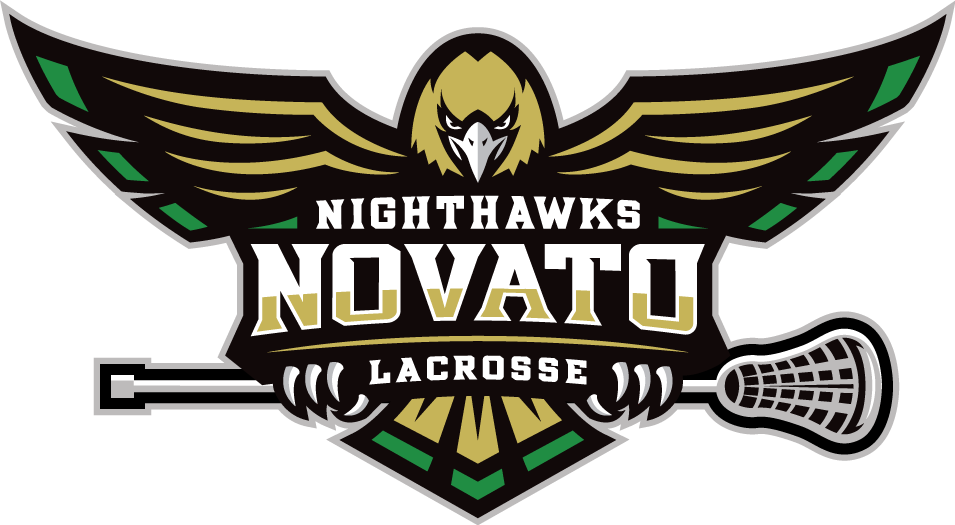Here are some useful terms for beginners and parents.
The Alley: The narrow lane on each side of the field from the End Line to the Restraining Line. Players will often be given the ball "In the Alley" after an out of bounds or a penalty resulting in loss of possession.
Ball or Ball Down: All players shout "BALL DOWN" any time the ball is on the ground. Often this is the first indicator to the player who had it that he has dropped it. "BALL" signals the intent of a player to go after the ball instead of the man. (see "Man/Ball" below)
Body Check: Defensively using the body to hit an opposing ball carrier or while contesting an opponent for a loose ball. The body check must always be done above the waist and from the front or side
The Box: The rectangular shaped area around the crease / goal, from the GLE to the Restraining Line, and out 20 yards from the goal to each side. Defenders seldom press players outside of the box. The distance involved makes it all but impossible to score from outside of the box.
Bull Dodge: While protecting the stick, cradling outside (behind the body in this case, typically), the ball carrier runs through the defenseman, bulling past him toward the goal.
Butt: The end of a crosse opposite the head. All shaft ends need to be covered with a butt-cap.
Carry the Pizza: When a ballcarrier holds his stick out in front of him, instead of cradling. Also known as the “frying pan”, “walking the dog”.
Change Planes: When a shooter has a close in shot, the goalie must respect where the ballcarrier starts his shot. If the shooter holds his stick high, the keeper does the same. Therefore it is most effective for the shooter to start high and shoot low, or vice versa. This is ‘changing planes’.
Clamping: On the face-off, a player pushes the back of his stick down on the ball in the attempt to gain control of it.
Clearing: An important defensive maneuver where defending players run or pass the ball out of their goal area. Clearing is best done along the sidelines, away from the front of the goal.
Cradling: In order to maintain control of the ball when moving along the field, players turn their wrists and arms to cradle the ball in the stick pocket.
Crease: The eighteen-foot diameter circle surrounding each team’s goal.
Cutter: An attacking player without the ball darts around a defender toward the goal in order to receive a “feed pass.” A cutting player is a "cutter", and wing attackmen are often talented cutters.
D-Cut: A maneuver used by an attackman to get open for a shot. The player starts on the GLE, about 5 yards away from the goal. He then makes a rounded cut, on the side away from the ball (completing a "D" shape).
Extra Man (aka Man Up or EMO): Describes the team at a player advantage in a penalty situation. Opposite of man down.
Face-off: Takes place at the start of each quarter, after every goal, and after certain dead balls. Two opposing players crouch down at midfield, hold their sticks flat on the ground. The ball is placed between the pockets and, when signaled to start, the players “rake” or clamp on the ball to vie for control.
Face Dodge: A player with the ball cradles the stick across his face in an attempt to dodge a stick-poking defender. Generally an open field dodge that does not involve changing hands.
Fast Break: When an offensive team quickly mounts a scoring attack enabling them to gain a man advantage over the opposing defense.
Feed Pass: An offensive play in which one player passes the ball to a cutting teammate for a “quick stick” shot on goal.
Flag Down (also “Play-On”): Tells our offense that a penalty will be called against the defense. Play is permitted to continue until we take a shot or the ball hits the ground. The referee will then halt play.
Gilman Clear: A defender or the goalie clears the ball by throwing it as far as he can down the field. Sometimes this is a desperation move, but it is often better to create a ground ball situation in the opponents end than around our own goal area.
GLE (Goal Line Extended): An imaginary line that extends straight out from the sides of the goal line.
Ground Balls: Players compete for the control of loose ground balls by checking opponents away from the ball while simultaneously trying to scoop it up. Players yell "BALL DOWN" when the ball is on the ground. See also "RELEASE".
The Hole (also known as "The Dirt"): A roughly yard square area in front of the crease. Also known as "the dirt" because the turf takes a lot of traffic, there is usually not much grass left on this part of the field. This is a much smaller area than "the box."
Invert: Any offensive play that involves "inverting" the middies and the attack. In a man on man situation, this puts the defensive longpoles out on top with our attack, and the short stick middies defending the area around the crease.
Lift Check: A check where the defender settles his stick under the stick of the ballcarrier and lifts until the ballcarrier loses control. An effective but difficult stick check.
Longpole: Slang for defensemen.
Man Down: Describes the team which has lost a player to the penalty box and must play with fewer men on the field, similar to the "shorthanded" team in hockey. Man Down teams are often tricky, since it is likely that a defender was penalized.
Man Up: Describes the team which has an advantage in player numbers on the field due to a penalty, similar to the "power-play" team in hockey.
Man-to-man: A defensive setup in which each defending player guards a specific offensive opponent.
Middie Back: A call to remind a midfielder (“Middie”) to stay back to allow a defensemen to cross the midfield line without causing an offside call.
Number Up: Goalie command alerting defensemen to pick up a man. Followed by the defensemen calling out the number of the man each is taking.
Offside: More than 6 players in the offensive end or 7 players (including the goalie) in the defensive end of the field.
Out-of-bounds: When a shot goes out of play, the player closest to the sideline where the ball went out gets the ball. This is one of many responsibilities of the "X" player on offense/ attack.
Passing: Integral to quickly moving the ball. Players throw overhand (or underhand) to each other. In most cases a high pass is easier to deal with than a low bouncing dribbler. Slowly thrown lobbed passes give the defense time to react and often result in the catching player being hit before the pass arrives (the dreaded "buddy pass"). We prefer that passes be ‘zipped’, or thrown with authority, instead of lobbed with a high arc.
Pick: An offensive player without the ball positions himself against the body or in the path of a defender to allow a teammate to get open and receive a pass or take a shot. Picks must be stationary and "passive".
Pocket: The net of the stick in which the ball is held and carried. The pocket is strung with mesh (or leather). In order to be legal, the top of a ball cannot be seen when looking at the pocket from the side.
Poke Check: A defender jabs his stick at the exposed stick end or hands of an opposing ballcarrier in an effort to jar the ball loose. These checks are very effective in that the checking player stays in balance and keeps a cushion of space between himself and the ballcarrier.
Quick Stick: When the ball reaches an offensive player’s stick on a feed pass, he catches it and then shoots it toward the goal in one swift motion.
Rake: A face-off move by a player who, in trying to gain possession of a ground ball, places the head of his stick on top of the ball and sweeps it back. Raking is "BAD" except for the face-off and for goalies. In play, it is done standing still. This means that players who rake will be legally hit by an opposing player. Raking is a very bad habit that is difficult to unlearn.
Release: Players shout "RELEASE" when they succeed in scooping a ground ball. This indicates to teammates that they can no longer make contact with the opponents to drive them away from the ball. Doing so is a penalty.
Restraining Line: Line restraining attackmen and defensemen during a faceoff. These players cannot cross the line until the referee establishes possession. Also forms the top of “the Box”.
Ride: When an attacking team loses possession of the ball, it must quickly revert to playing defense in order to prevent the ball from being cleared back out. In most ride situations, the goal-keeper will be left un-marked by an attacker, as they are matched up 1-1 with their longpole counterparts.
Roll Dodge: An offensive move in which a ballcarrier, using his body as a shield between a defensive player and the cradled ball, spins around the defender. To provide maximum ball protection, the ballcarrier switches hands as he rolls.
Scoop: The manner in which a player picks up loose ground balls. He bends toward the ground, bends his knees to get low, slides the pocket of his stick underneath the ball, and lifts the ball into the netting of the stick.
Screen: An attacking player without possession of the ball positions himself in front of the opposing goal crease in an effort to block the goalkeeper’s view.
Shaft: A hollow aluminum or composite pole connected to the head of the crosse.
Skip: To pass to a non- adjacent teammate, usually a long pass over another player. Also known as a skip pass.
Slap Check: A stick check, inferior to the poke check for most defensive players. The defender uses his stick to slap the stick of the offensive player who has the ball. Poke checks are preferred to slap checks since it is easier to keep moving and balanced during the check.
Slide: When an offensive player with the ball has gotten past his defender, a defending teammate will shift his position to pick up that advancing player.
Squib: To kick a ground ball out of a scrum to an open teammate, or kick it ahead to yourself.
Stick Check: In an effort to dislodge the ball from the ballcarrier's “pocket,” the defending player strikes his stick against the stick of an opposing player in a controlled manner.
Support: When a player without the ball moves into a position where the player with the ball can make a clear pass. Often accompanied by saying "Here's Your Help".
Transition: When a team from defense to offense.
Unsettled: Any situation in which the defense is not positioned correctly, usually due to a loose ball or broken clear, or fast break. A high-probability scoring opportunity for an offense, and a scramble for the defense.
V Cut: A maneuver used by an offensive player to get open for a pass. The offensive player feints in causing his defender to react and move, he then cuts sharply away (completing the "V" shape) See also “D cut”
X: The area behind the goal, and usually the player who starts on attack at that point (as opposed to the "cutters"). The player at X often has a pass-first, assist driven mentality.
Zone Defense: When defenders play in specific areas of their defensive zone, rather than covering man-to-man.

Follow Us
News, Schedules, Trainings, and Special Events are announced on these platforms.

